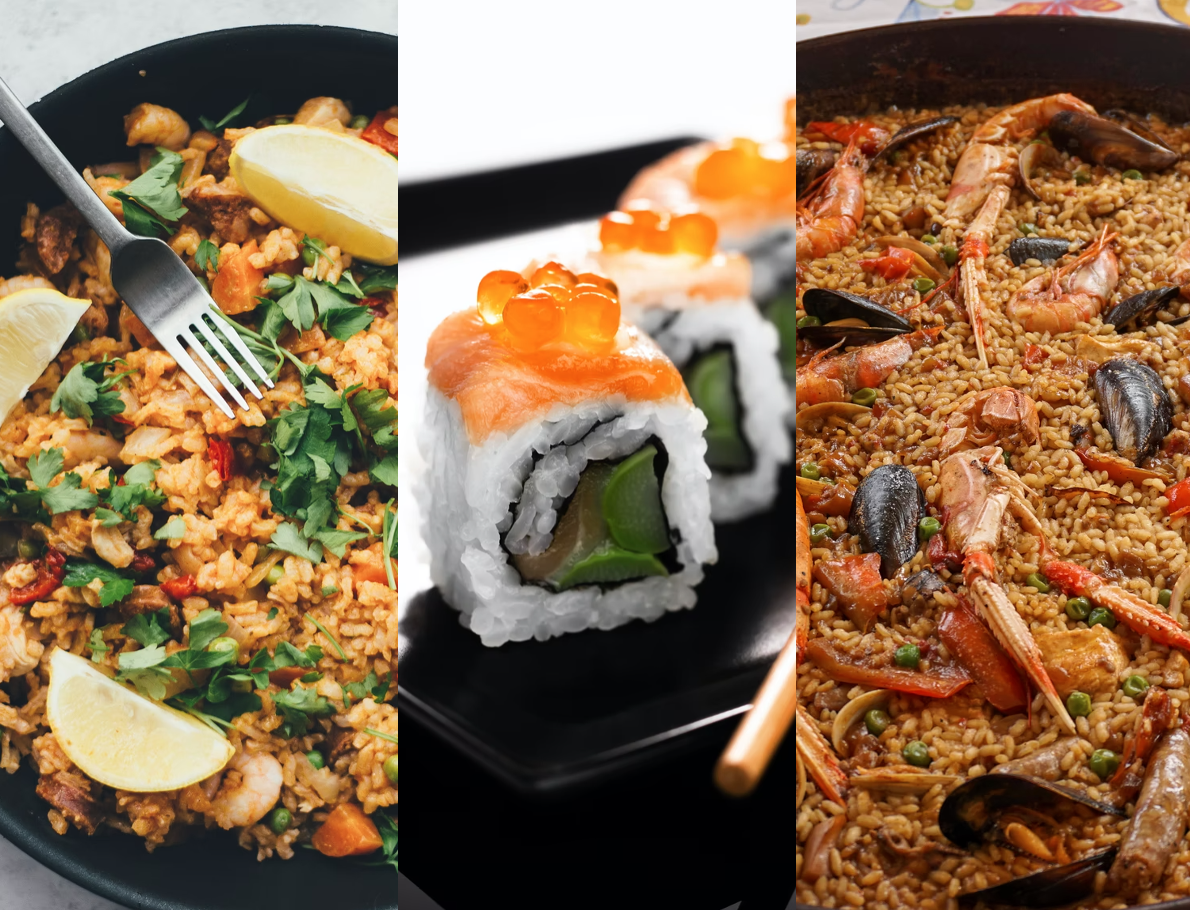Rice and Diabetes: How Great is the Risk?
By Eliza Skoler
 Rice is a main food staple in many cultures, but it can cause glucose spikes for people with diabetes. From rice alternatives to smaller portions, here are some ways to navigate this challenge.
Rice is a main food staple in many cultures, but it can cause glucose spikes for people with diabetes. From rice alternatives to smaller portions, here are some ways to navigate this challenge.
Can you eat rice with diabetes? A guide to navigate this high-carb grain
Rice. Billions of people around the world eat it every single day, for multiple meals a day – and it’s a primary food for many populations, with research showing that it provides about 20% of the world’s calorie intake. From beans and rice to stir fry with rice, from sushi to risotto to sweet rice desserts, this simple ingredient is a staple across the globe and across cultures.
Unfortunately, rice presents a key challenge for people with diabetes: it’s a spiky carb. Spiky carbs are foods that cause glucose to quickly increase, and they can create unpredictable swings in glucose levels. If you or someone you know has diabetes, you may be wondering how to manage your glucose when faced with this dietary staple.
Though it may not be what anyone wants to hear, when it comes to rice, the easiest way to keep your glucose levels stable is to avoid eating it. For people with diabetes, this is true for most high-carb foods, like white bread, pasta, and cake. That said, for many cultures, rice may be an important (and even essential) component of meals.
While your diabetes care team might recommend eliminating rice entirely, this might not be possible for you and your family. We want to help navigate this dietary challenge in a way that acknowledges and embraces cultural values. Here are our strategies to help you enjoy your mealtime while minimizing the potential glucose swings.
Best Rice for People with Diabetes: White Rice vs. Brown Rice
Brown rice and wild rice are whole grain foods. Whole grains are a healthy food option, containing vitamins, minerals, and complex carbohydrates. In addition they contain more fiber, which has the benefit of slowing the uptake of carbs in the body.
White rice, on the other hand, is a refined grain. Refined grains contain much less fiber and can lead to unwanted glucose spikes when eaten.
Eat smaller portions of rice.
If you’re going to eat rice – white rice or brown rice – an important modification is to try eating a smaller portion. Simply eating fewer carbs means that there is also less glucose that goes into your bloodstream. When you do this, try adding more vegetables or protein to your plate, and less rice.
diaTribe recommends that people with diabetes try to eat between 100-150 grams of carbohydrate per day, meaning that about 25-30% of a person’s daily calories should come from carbs. It’s even easier for people with diabetes to keep blood glucose levels in range when carbs are limited to no more than 30 grams at each meal or snack. And, it’s especially helpful to eat carbohydrates along with fiber. Fiber comes from vegetables and fruits, nuts and seeds, legumes like beans and lentils, and whole grains. The American Diabetes Association recommends that people with diabetes eat at least 14 grams of fiber per 1,000 calories – or about 28 grams of fiber per day for women and 34 grams of fiber per day for men.
Glycemic Index of Rice – The Impact on Blood Sugar
Here’s the carb and fiber break-down for different types of cooked rice. As a general rule, you want to aim for fewer carbohydrates and more fiber. That’s why brown rice and wild rice are the two best options in this table – wild rice has lots of fiber and less carbs, while brown rice, though still a little high in terms of carbs, has greater amounts of fiber than white rice.
|
Type of rice |
Quantity |
Carbohydrates |
Fiber |
|
Wild rice |
½ cup |
17.5 grams |
1.5 grams |
|
Brown rice, medium-grain |
½ cup |
23 grams |
1.8 grams |
|
Brown rice, long-grain |
½ cup |
26 grams |
1.6 grams |
|
White rice, long-grain |
½ cup |
22 grams |
0.3 grams |
|
White rice, medium-grain |
½ cup |
27 grams |
0.3 grams |
|
White rice, short-grain |
½ cup |
27 grams |
N/A |
|
Glutinous white rice |
½ cup |
18 grams |
0.9 grams |
Rice Substitutes for People with Diabetes.
You can experiment with other side dishes that stand in for rice too. Whole grains like quinoa, barley, or buckwheat can be good alternatives that are lower in carbohydrates and higher in fiber. If you’re looking to really reduce carbs, try making cauliflower rice – with low-carb cauliflower – this newer alternative is a great rice substitute with a similar texture.
While a half cup of cooked rice contains about 25 grams of carbohydrates (depending on the grain), here’s how some alternatives compare:
|
Rice alternative |
Quantity |
Carbohydrates |
Fiber |
|
Quinoa |
½ cup |
20 grams |
2.6 grams |
|
Buckwheat |
½ cup |
17 grams |
2.3 grams |
|
Barley |
½ cup |
22 grams |
3 grams |
|
Millet |
½ cup |
21 grams |
1.1 grams |
|
Cauliflower rice |
½ cup |
2 grams |
1.2 grams |
Ask your family and friends to help out.
Talk with your loved ones and explain that you are trying to eat less rice to better manage your diabetes. Ask if they’ll help you out. Here are some strategies you can try together:
-
Eat rice at one less meal each week; over time you can increase the number of meals that don’t include rice.
-
Make brown rice, or a rice substitute like cauliflower rice, for everyone instead of white rice.
-
Work together as a family to hold each other accountable and replace larger servings of rice with more vegetables and protein.
Your support network and loved ones might also be interested to know that several research studies show that eating lots of white rice is associated with a higher risk of type 2 diabetes, compared to eating mostly brown rice.
One large-scale study of almost 200,000 people estimated that replacing small servings of white rice (50 grams per day) with the same amount of either brown rice or other whole grains could reduce a person’s chance of developing type 2 diabetes by 16% or 36% respectively.
In another study of over 130,000 people in 21 countries, the more white rice people ate, the greater their risk for developing type 2 diabetes (around 20% higher risk) – of note in this study, the risk did vary in different areas of the world. For example, in South Asia, there was a 65% greater risk for developing type 2 diabetes in those with high versus low white rice consumption.
This research might give the people in your life one more reason to join you in reducing their rice consumption. Having diabetes doesn’t mean the end of your family’s favorite meals – it just means starting to make small changes that will help you manage your health. No matter where you are in your diabetes journey, if you’re eating rice it’s a good idea to evaluate your habits. Remember, more stable glucose levels will make you feel better and are good for your overall health in the long run.
Want to learn more about navigating dietary challenges in a way that is culturally inclusive? Read our article: “How Can We Make Mainstream Trends of Health and Wellness More Inclusive of Other Cultures?”
This article is part of a series on nutrition to support people with diabetes, funded in part by The Ella Fitzgerald Charitable Foundation.








